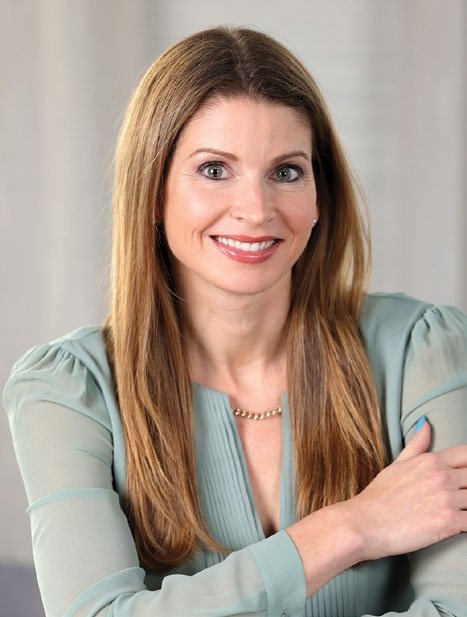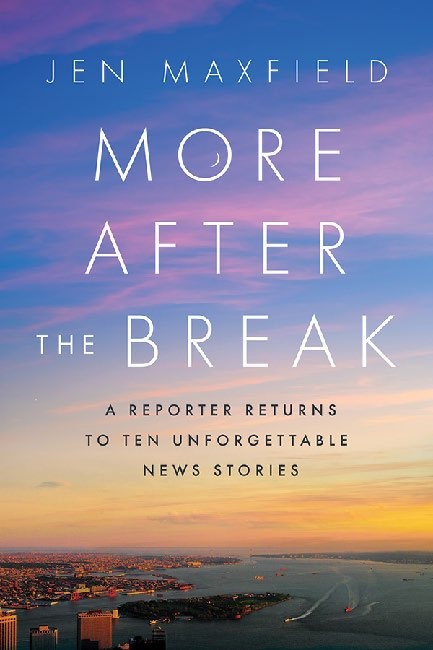Columbia College | Columbia University in the City of New York
A Reporter Returns

Jen Maxfield ’99, JRN’00
JAMES CLARK, INSYNC NEW YORK PHOTOGRAPHY
While covering a news event in 2021, Maxfield coincidentally spoke with an interview subject from six years earlier: the grandmother of a 15-year-old basketball phenom who had been murdered in a case of mistaken identity. The chance run-in — and learning what had ultimately happened with the family — prompted Maxfield to reconnect with other subjects who had stayed on her mind.
The result is More After the Break: A Reporter Returns to Ten Unforgettable News Stories (Greenleaf Book Group, $26.95). In it, Maxfield revisits the story of a waiter who lost his legs in the 2003 Staten Island Ferry crash, a young mother who was saved from a brutal stabbing by her toddler daughter and, the subject of her Journalism School master’s thesis, an Ivy League undergrad sentenced to decades in prison under the now-defunct Rockefeller Drug Laws.
“Part of what made these stories interesting to me is these people didn’t ask to be in the spotlight,” Maxfield told CCT. “What is it like to have your life upended, when everyone knows what happened to you — and then all the attention goes away?”
Maxfield is interested in demystifying the process of how news gets covered, and describes piecing these comprehensive histories together from eyewitness accounts, court transcripts, letters, archived news reports and more. She was able to get through to people who are now speaking for the first time, happy that someone cared enough to reach out to them.
Others were willing to reopen old wounds to talk with Maxfield again; an especially heartbreaking chapter, “Friday Night,” revisits a 2011 story about the death of 23-year-old Tiffany Jantelle, who was struck by a drunk driver while trying to help an injured dog. Maxfield remained close with Jantelle’s mother, Corinne, who was willing to participate in a follow-up in order to honor Tiffany’s legacy and help other parents who have lost children.
“Telling stories with care opens up avenues for the families to heal,” Maxfield says. “It allows other people to help, and encourages them to support their neighbors.”
Maxfield frequently reports on her home state of New Jersey. The oldest of six, Maxfield was a varsity high jumper at Tenafly H.S. — she held the school’s 5'3" record for 26 years — and planned to pursue a career in sports medicine. She joined Spectator because she loved to write; a political science major and news junkie, Maxfield wrote a snappy op-ed column, “The Max Factor.” (She met her husband, Scott Ostfeld ’98, LAW’02, BUS’02, in an art history class; they have three children.)
Though she says her time at Spec was formative, she didn’t consider journalism as a profession until she got an internship with CNN covering the United Nations. “In the winter of my junior year I was going to the U.N. every Friday,” she recalls.
Maxfield was hired by CNN as a production assistant and guest booker while she was still an undergrad. “That behind-the-scenes experience really helped me to understand how the process works,” she says. She entered the Journalism School right after graduation; by that time, she knew she wanted to be the person going out and doing the interviews. “I understood the ownership of the story from that standpoint,” she says.
Her first reporting job was with an ABC affiliate in Binghamton, N.Y.; she moved back to the city in 2002 and spent 10 years at Eyewitness News (ABC7) before joining NBC New York in 2013. Maxfield became an adjunct professor at the Journalism School in 2016.
She researched and wrote the book in just 10 months, on her days off. Maxfield resisted following up with higher-profile subjects, like the heroic pilot Chesley “Sully” Sullenberger. “The people I was interested in were the ones who seemed to have faded back into obscurity,” she writes in the book’s introduction, excerpted here. “The men and women whose last Google search result dated back to when they first appeared on the news.”
The intro’s title, “The Door Knock,” references the difficulty of knocking on a grieving family’s door in search of accurate information. “A lot of reporters go into the business because they care about people, and they care about trying to get the story right,” she says. “And a lot of them feel like I do — we might be assigned to a different story the next day, but we’re still thinking about that person whose living room we were sitting in the day before. It’s just that we don’t always have the opportunity to return.”
— Jill C. Shomer
The Door Knock

I do all of this without any preparation. Yes, I worked at CNN, wrote for the Columbia Daily Spectator, and earned a master’s degree from Columbia Journalism School before I ever filed a single TV news report. But every day in local news is a fresh challenge, a journey into the unknown. We show up to work not knowing where we will go or who we will meet. This uncertainty poses some logistical challenges, a reporter version of Murphy’s Law. Wearing new shoes? You’ll be assigned to cover a flood. Have concert tickets with friends for seven p.m.? Practically a guarantee you’ll have a six p.m. live shot across the state. Think you got an easy assignment in a beautiful Jersey Shore town? Sure, until someone tries to run you down with their SUV when you’re covering their parish priest accused of embezzling millions. And yes, that all actually happened.
The story I am assigned after our morning meeting may be changed three times before noon. We could drive one hundred miles in the live truck for an interview, only to be diverted to breaking news as soon as we arrive. At least now we have GPS to prevent us from getting lost. When I started reporting in 2000, we kept a milk carton full of map books in the live truck, and I navigated while the photographer drove. Find the right county book, look up the town in the index, find the street name, go to page 16, Grid C4. Map reading truly is a lost art.
All that effort was before we emerged from the live truck to start gathering interviews. We could knock on dozens of doors without getting a single person to talk. We could knock on one door and get screamed at before they slammed it in our faces. And yet, every day we went live from somewhere, broadcasting to our community, talking to our neighbors about what happened that day.
A frequent (and fair) criticism of local news that I’ve heard since I was a student at Columbia is that we don’t do enough follow-up. We descend upon a news event, collect our information, broadcast our reports, and then move on to the next story. Every assignment ends with a cliffhanger and we never get to watch the next episode. Part of this is the business model of local news: reporters gather interviews, report, and write as many as three stories for broadcast every day. But part of this also feels like self-preservation. With all our exposure to chaos and sadness, the healthier option may be to not linger. We dip our toes in the pool of your grief but never jump in for fear of drowning.
Just because the news cycle has moved on and we are chasing another story, it doesn’t necessarily mean the relationship between the reporter and subject ends. My first mentor in news, Gary Tuchman, a national correspondent for CNN, told me recently that he will come across a name in his address book and reach out years — even decades — after their stories have aired. People who lost loved ones in the 1995 Oklahoma City bombing, or on TWA Flight 800.
“I call them to check in, see how they’re doing,” Gary explained. “I want them to know that I care, and that they meant more to me than just a sound bite on the news.”
Speaking with other friends and colleagues, it’s clear that many of us want to stay connected with people featured in our news stories long after the headlines have updated. Unlike my work conducted through texting, emails, and Zoom, short face-to-face encounters with strangers can have outsized impact. Many of us who interact with the public share this sensation of feeling like we intimately know someone soon after meeting them. Police officers who are humbled by a particular 911 call. Nurses who never forget a patient. A military officer who remembers the children from the town where she served. A minister who counseled a couple and wonders if they stayed together. A store clerk who recalls an elderly customer. A social worker who is curious about what happened to that child he helped after she went back to her parents.
Since the first day I started reporting for NewsChannel 34 in Binghamton, New York, I have questioned my role and responsibility for telling other people’s stories. I appear during traumatic times in their lives with no special training. I cannot offer medical advice or spiritual guidance. I cannot help them heal their pain, and I can neither arrest nor prosecute the person responsible. I do not deliver the bad news, but I am there to report on it and try to understand it, before rushing out to make my deadline for the evening news.
What I can offer is the space to tell their story. To listen and to repeat. To question and to share. Like our ancestors drawing on the walls of caves, humans all share the instinct to exchange information, and the most compelling way to do this is by telling a story. As difficult as it may be for a person to speak with us from their hospital bed, as excruciating as it may be for a family member to construct sentences in the haze of their grief, as overwhelming as it may be to make sense of a breaking news scene, the people who speak to me understand that they are constructing their legacy. And that their story will be an integral part of our community’s shared history.
As an adjunct professor at Columbia Journalism School, I share the same wisdom with my students that was passed down by my news director at ABC in New York, Kenny Plotnik: “Find the eyewitness and tell me their story.” Without the personal perspective, the news is just a collection of facts, the same thing you could find in your local police blotter. Yes, many stories contain object lessons for the viewer: look both ways before crossing the railroad tracks, read your teenager’s text messages, learn the Heimlich maneuver. But the most unforgettable news stories include universal truths about love and devotion. We bear witness so that these stories are not forgotten.
This excerpt of More After the Break, by Jen Maxfield, is presented with permission from the author and Greenleaf Book Group. For more information, please visit jenmaxfield.com.
Issue Contents
Published three times a year by Columbia College for alumni, students, faculty, parents and friends.
Columbia Alumni Center
622 W. 113th St., MC 4530, 6th Fl.
New York, NY 10025
212-851-7852
cct@columbia.edu
Columbia Alumni Center
622 W. 113th St., MC 4530, 4th Fl.
New York, NY 10025
212-851-7488
ccalumni@columbia.edu

